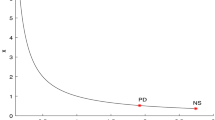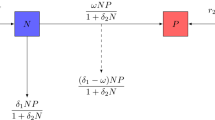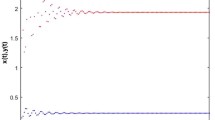Abstract
The aim of this paper is to introduce a two-dimensional discrete-time prey–predator, identify its fixed points, as well as investigate one- and two-parameter bifurcations. Numerical normal forms are used in bifurcation analysis. For this model, the Neimark-Sacker, period doubling and strong resonance bifurcations are observed. Based on the critical coefficients, the bifurcation scenarios can be identified. Based on numerical continuation methods, we use the MATLAB package MatContM to verify the analytical results and observe complex dynamics up to 16- iterate.












Similar content being viewed by others
References
Zhu, Y.L., Zhou, W., Chu, T., Elsadany, A.A.: Complex dynamical behavior and numerical simulation of a Cournot-Bertrand duopoly game with heterogeneous players. Commun. Nonlinear Sci. Numer. Simul. 101, 105898 (2021)
Atabaigi, A., Akrami, M.H.: Dynamics and bifurcations of a host-arasite model. Int. J. Biomath. 10(06), 1750089 (2017)
Li, B., Liang, H.J., Shi, L., He, Q.Z.: Complex dynamics of Kopel model with nonsymmetric response between oligopolists. Chaos Solitons Fractals 156, 111860 (2022)
Din, Q.: Dynamics and chaos control for a novel model incorporating plant quality index and larch budmoth interaction. Chaos Solitons Fractals 153, 111595 (2021)
Jiang, X.W., Chen, X., Huang, T., Yan, H.: Bifurcation and control for a predator-prey system with two delays. IEEE Trans. Circuits Syst. II Express Briefs 68(1), 376–380 (2021)
Li, H., Zhou, W., Elsadany, A.A., Tong, C.: Stability, multi-stability and instability in Cournot duopoly game with knowledge spillover effects and relative profit maximization. Chaos Solitons Fractals 146, 1100936 (2021)
Govaerts, W., Kuznetsov, Y.A., Meijer, H.G.: Numerical methods for two-parameter local bifurcation analysis of maps. SIAM J. Sci. Comput. 29(6), 2644–2667 (2007)
Ghaziani, R.K., Govaerts, W., Sonck, C.: Resonance and bifurcation in a discrete-time predator-prey system with Holling functional response. Nonlinear Anal. Real World Appl. 13(3), 1451–1465 (2012)
Cheng, L.F., Cao, H.J., Zhang, L.T.: Two-parameter bifurcation analysis of an aircraft nose landing gear model. Nonlinear Dyn. 103, 367–381 (2021)
Eskandari, Z., Alidousti, J., Avazzadeh, Z., Machado, J.T.: Dynamics and bifurcations of a discrete-time prey-predator model with Allee effect on the prey population. Ecol. Complex. 48, 100962 (2021)
Eskandari, Z., Alidousti, J., Ghaziani, R.K.: Codimension-one and-two bifurcations of a three-dimensional discrete game model. Int. J. Bifurc. Chaos 31(02), 2150023 (2021)
Li, B., Liang, H.J., He, Q.Z.: Multiple and generic bifurcation analysis of a discrete Hindmarsh-Rose model. Chaos Solitons Fractals 146, 110856 (2021)
Lotka, A.J.: Elements of Physical Biology. Williams & Wilkins, Ambler (1925)
Lotka, A.J.: Fluctuations in the abundance of a species considered mathematically. Nature 119(2983), 12–12 (1927)
Kumar, V., Kumari, N.: Stability and bifurcation analysis of fractional-order delayed prey-predator system and the effect of diffusion. Int. J. Bifurc. Chaos 32(1), 2250002 (2022)
AlSharawi, Z., Pal, N., Chattopadhyay, J.: The role of vigilance on a discrete-time predator-pery model. Discret. Contin. Dyn. Syst. Ser. B (2022). https://doi.org/10.3934/dcdsb.2022017
Zou, X.L., Lv, J.L., Wu, Y.P.: A note on a stochastic Holling-II predator-prey model with a prey refuge. J. Franklin Inst. 357(7), 4486–4502 (2020)
Jiang, Z.C., Zhao, Y., Bai, X.L., Zhang, Z.X.: Bifurcation and control of a planktonic ecological system with double delays by delayed feedback control. J. Franklin Inst. 358(7), 3609–3632 (2021)
Arsie, A., Kottegoda, C., Shan, C.H.: A predator-prey system with generalized Holling type IV functional response and Allee effects in prey. J. Differ. Equ. 309, 704–740 (2021)
Mu, Y., Lo, W.C.: Bifurcation analysis of a competitive system with general toxic production and delayed toxic effects. J. Franklin Inst. (2022). https://doi.org/10.1016/j.jfranklin.2022.05.019
Kuznetsov, Y.A.: Elements of Applied Bifurcation Theory, vol. 112. Springer, Berlin (2013)
Kuznetsov, Y.A., Meijer, H.G.: Numerical normal forms for codim 2 bifurcations of fixed points with at most two critical eigenvalues. SIAM J. Sci. Comput. 26(6), 1932–1954 (2005)
Govaerts, W., Ghaziach, R.K., Kuznetsov, Y.A., Meijer, H.G.: Numerical methods for two-parameter local bifurcation analysis of maps. SIAM J. Sci. Comput. 29(6), 2644–2667 (2007)
Kuznetsov, Y.A., Meijer, H.G.: Numerical Bifurcation Analysis of Maps: From Theory to Software. Cambridge University Press, Cambridge (2019)
Funding
This work was supported by National Natural Science Foundation of China (Grant Nos. 11626029), Natural Science Foundation of Anhui Province of China (Grant Nos. 2008085QA09, 1908085MG232) and Scientific Research Foundation of Education Department of Anhui Province of China (Grant No. KJ2021A0482).
Author information
Authors and Affiliations
Contributions
ZE: Methodology, Conceptualization, Software, Formal analysis, Writing—original draft. ZA: Investigation, Validation, Software, Formal analysis, Writing—original draft. BL: Writing—review & editing, Visualization, Investigation.
Corresponding author
Ethics declarations
Conflict of interest
The authors declare that they have no known competing financial interests regarding the work reported in this article.
Additional information
Publisher's Note
Springer Nature remains neutral with regard to jurisdictional claims in published maps and institutional affiliations.
Rights and permissions
Springer Nature or its licensor (e.g. a society or other partner) holds exclusive rights to this article under a publishing agreement with the author(s) or other rightsholder(s); author self-archiving of the accepted manuscript version of this article is solely governed by the terms of such publishing agreement and applicable law.
About this article
Cite this article
Li, B., Eskandari, Z. & Avazzadeh, Z. Strong resonance bifurcations for a discrete-time prey–predator model. J. Appl. Math. Comput. 69, 2421–2438 (2023). https://doi.org/10.1007/s12190-023-01842-2
Received:
Revised:
Accepted:
Published:
Issue Date:
DOI: https://doi.org/10.1007/s12190-023-01842-2
Keywords
- Prey–predator model
- Numerical continuation method
- Neimark-Sacker bifurcation
- Strong resonance
- Two-dimensional bifurcation diagram




